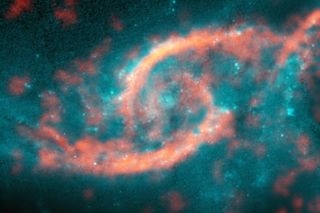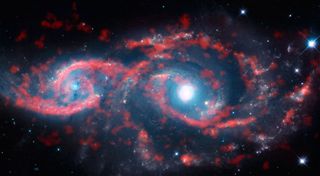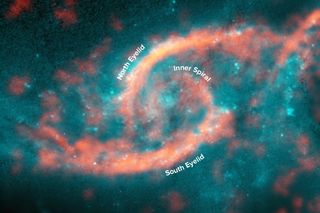Galactic 'Eyelids' Show Space Gas 'Tsunami' (Photo)

Look out! A "tsunami" of gas is crashing through a spiral galaxy, creating an image that bears a striking resemblance to a pair of eyelids.
The turbulent zone formed when a galaxy called IC 2163 brushed by another one, named NGC 2207. The spectacular feature is expected to last a few tens of millions of years, researchers said in a statement. The collision zone, located some 114 million light-years from Earth, was inspected for a new study with the Atacama Large Millimeter/submillimeter Array (ALMA), a large radio observatory in Chile.
"Although galaxy collisions of this type are not uncommon, only a few galaxies with eye-like, or ocular, structures are known to exist," Michele Kaufman, lead author of the new work and an astronomer who was formerly with The Ohio State University, said in a statement that billed the formation as a sort of cosmic "tsunami." [Amazing Star Birth Photos from the ALMA Telescope]

The collision zone, some 114 million years away from Earth, was observed with the Atacama Large Millimeter/submillimeter Array (ALMA). The galaxies first rubbed against each other with their outer spiral arms, but they are expected to merge eventually.
Astronomers used ALMA's fine resolution to peer at carbon monoxide gas — a common fuel for star formation — in the galaxy. They saw gas in the outer zone of IC 2163 moving inward from the "eyelid" at more than 60 miles per second (100 kilometers per second).
But it doesn't keep up that pace. According to the observations, the gas decelerates as it moves to the inside, and then changes direction to move with the galaxy's rotation instead of heading straight for the center. The gas also becomes denser as it decelerates, gathering together in the "eyelid" zone to provide a potential star formation hotspot, the researchers said.

"What we observe in this galaxy is very much like a massive ocean wave barreling toward shore until it interacts with the shallows, causing it to lose momentum and dump all of its water and sand on the beach," Bruce Elmegreen, co-author of the paper and a scientist with IBM's Thomas J. Watson Research Center in Yorktown Heights, New York, said in the statement.
Get the Space.com Newsletter
Breaking space news, the latest updates on rocket launches, skywatching events and more!
A The paper based on the research was published in The Astrophysical Journal, according to the statement; you can read a recent draft on the archival website arXiv.
Follow Elizabeth Howell @howellspace, or Space.com @Spacedotcom. We're also on Facebook and Google+. Originally published on Space.com.
Join our Space Forums to keep talking space on the latest missions, night sky and more! And if you have a news tip, correction or comment, let us know at: community@space.com.

Elizabeth Howell (she/her), Ph.D., is a staff writer in the spaceflight channel since 2022 covering diversity, education and gaming as well. She was contributing writer for Space.com for 10 years before joining full-time. Elizabeth's reporting includes multiple exclusives with the White House and Office of the Vice-President of the United States, an exclusive conversation with aspiring space tourist (and NSYNC bassist) Lance Bass, speaking several times with the International Space Station, witnessing five human spaceflight launches on two continents, flying parabolic, working inside a spacesuit, and participating in a simulated Mars mission. Her latest book, "Why Am I Taller?", is co-written with astronaut Dave Williams. Elizabeth holds a Ph.D. and M.Sc. in Space Studies from the University of North Dakota, a Bachelor of Journalism from Canada's Carleton University and a Bachelor of History from Canada's Athabasca University. Elizabeth is also a post-secondary instructor in communications and science at several institutions since 2015; her experience includes developing and teaching an astronomy course at Canada's Algonquin College (with Indigenous content as well) to more than 1,000 students since 2020. Elizabeth first got interested in space after watching the movie Apollo 13 in 1996, and still wants to be an astronaut someday. Mastodon: https://qoto.org/@howellspace
